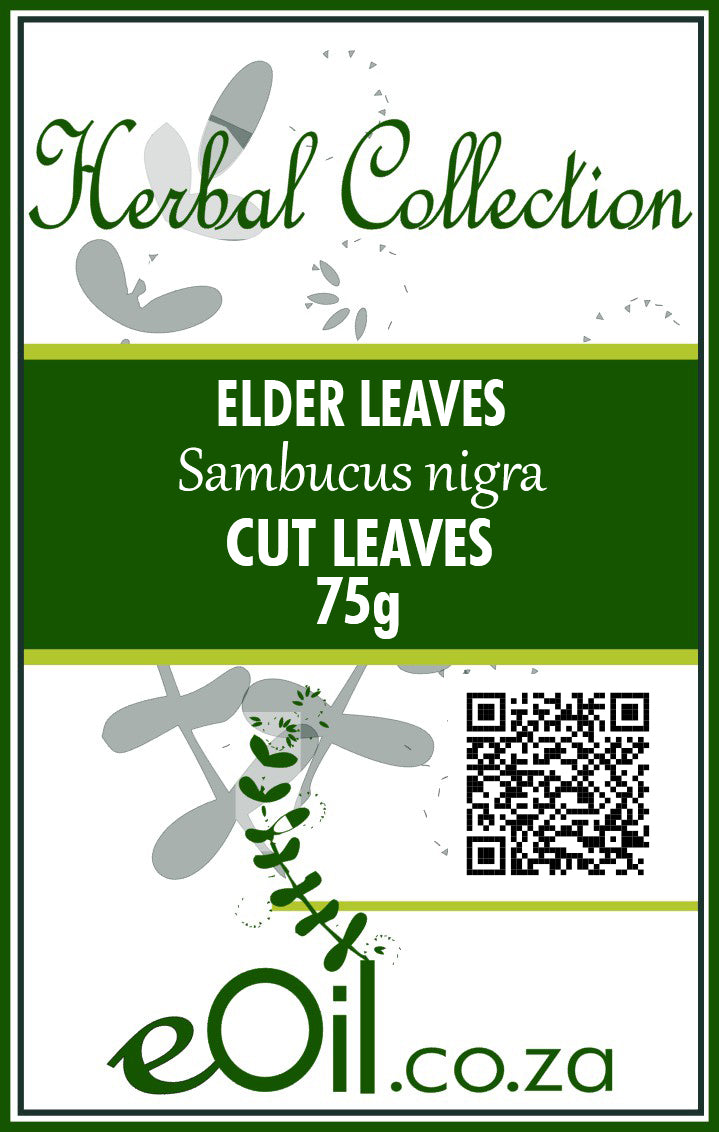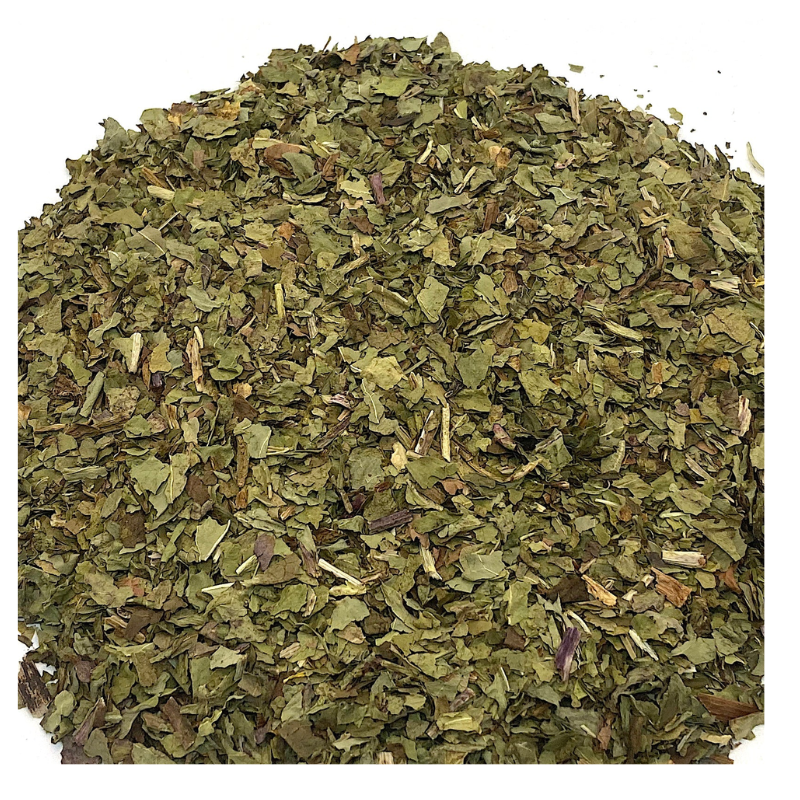Elder leaves cut - Herbal Collection
Elder leaves cut - Herbal Collection - 75 GR is backordered and will ship as soon as it is back in stock.
Description
Description
Elder Leaves Cut (Sambucus nigra) are sun-dried and selected for traditional herbal blends and infusions.
Known for their earthy, green aroma, elder leaves have been used in topical preparations and homemade teas.
Ideal for botanical ointments or herbal crafts, they are pure, natural, and free from additives
TRADITIONALLY USED FOR
While elderflower is the most popular part of the elderberry plant for medicinal and culinary use, elder leaves also have some traditional applications. Let's explore those and the differences compared to elderflower tisane:
Traditional Uses of Dried Elder Leaf Tisane
Diuretic: Elder leaves are traditionally believed to have a diuretic effect, meaning they may help increase urine production. This could be used to support detoxification and manage fluid retention.
Opens in a new window
tmedweb.tulane.edu
- Topical Uses: Elder leaf tea was sometimes used as a wash or compress for:
- Minor skin wounds: Due to potential antiseptic and anti-inflammatory properties.
- Swollen joints: To potentially reduce inflammation and pain.
- Fevers: Some traditional medicine practices used elder leaf tea to help reduce fevers by promoting sweating.
How to Prepare Dried Elder Leaf Tisane
The preparation is similar to elderflower tisane:
- Dosage: Use approximately 1-2 teaspoons of dried, cut elder leaves per cup of hot water.
- Steeping: Steep in hot (not boiling) water for 5-10 minutes.
- Straining: Strain before drinking.
Differences Between Elder Leaf & Elderflower Tisane
- Taste: Elderflower tisane has a pleasant, floral sweetness. Elder leaf tisane will be more earthy and herbaceous, potentially slightly bitter.
- Main Uses:
- Elderflower: Focuses on immune system support, respiratory health, and its gentle, relaxing properties.
- Elder Leaf: Traditionally used more for detoxification support, potential wound care, and managing fevers.
Important Considerations
- Safety: It's crucial to note that elder leaves can be more problematic than elderflowers. They contain higher levels of compounds that can be toxic if not prepared correctly. It's generally advised to use elder leaves primarily for topical applications rather than internal consumption.
- Reliable Sources: It's best to purchase dried elder leaves from a reputable herbal supplier to ensure quality and proper preparation.
- Consultation: Before using elder leaf tisane internally, it's essential to talk to your doctor, especially if you have underlying health conditions or take medications.
INFORMATION
Source : http://www.wikiphyto.org/wiki/Sureau_noir
Reference on http://www.wikiphyto.org
Translation in English by Google Translate (go to the page of the source linked | on Chrome cellphones go on the 3 dots on the top right and select translate in your preferred language | on laptop right click your mouse and select option translate when hoovering on the page
plant name
Black elderberry, black elderberry (English)
International Latin denomination
botanical family
Adoxaceae (formerly Caprifoliaceae )
Description and habitat
- Shrub 4 - 5 m high with large opposite compound-odd-pinnate leaves, with 5-7 oval leaflets
- Inflorescences in large umbel-shaped corymbs (20 cm in diameter) with a delicate fragrance
- Ripe fruits are black and bursting with dark purple juice
- Common throughout Europe, Western Asia, North Africa, it can be invasive
- Delicate drying (possible blackening)
History and tradition
- Formerly considered a real “country pharmacy”
- We prepare the delicious elderberry donuts with the flowers
- Elderflowers were once used to purge "phlegm", one of the four Hippocratic humors, a nasal secretion believed to emanate from the brain
- The "phlegmatic" temperament or complexion would have favored certain diseases caused by the damp cold.
Parts used
- Dried flower containing at least 0.8% flavonoids expressed as isoquercitrin
- French Pharmacopoeia list A
- Fruit (drupes)
Dosage forms available
- Sambucus nigra (flowering top ) tincture
- Flower herbal teas
- Fruit, raw or in the form of syrup
- Berries Élusanes® ( hydro-alcoholic dry extract )
- Berries EPS
Usual dosages
- TM : 50 drops 4 times a day for adults
- Berries EPS
- Berry syrup: 15 ml (one tablespoon) 4 times a day
- Elderflower herbal tea, one cup 4 to 6 times a day
Composition
Main components of the plant
- Flowers: essential oil with a solid consistency (of butter), due to the presence of free fatty acids (66%), especially palmitic acid
- Mucilages and tannins
- Flavonoids 0.7 - 3.5%) ( flavonols and major compound rutoside , isoquercitroside , hyperoside , quercitroside ), 5,7,3',4'-tetra-O-methylquercetin , 5,7-dihydroxy-4-oxo- 2-(3,4,5-trihydroxyphenyl)chroman-3-yl-3,4,5-trihydroxycyclohexanecarboxylate , dihydromyricetin
- Hydroxycinnamic acid derivatives (5.1%) chlorogenic acid , p-coumaric acid , caffeic acid and ferulic acid
- Triterpene acids : ursolic and oleanolic
- Sterols (0.11%)
- Fruit:
- Flavonoids : rutoside , isoquercitroside , hyperoside , quercetin (29 to 60 mg/100 g)
- Anthocyanosides : sambucin , sambucyanin and chrysanthemin , cyanidin-3-sambubioside-5-glucoside , cyanidin-3,5-diglucoside , cyanidin-3-sambubioside , cyanidin-3-glucoside , cyanidin-3-rutinoside , pelargonidin-3-glucoside , pelargonidin-3-sambubioside
- Anthocyanin content of black elderberry fruit (Source Phenol-Explorer ):
- Cyanidin 3,5-O-diglucoside 17.46 mg/100 g
- Cyanidin 3-O-glucoside 794.13mg/100g
- Cyanidin 3-O-rutinoside 5.83mg/100g
- Cyanidin 3-O-sambubioside 462.96mg/100g
- Cyanidin 3-O-sambubioside 5-O-glucoside 34.48mg/100g
- Pelargonidin 3-O-glucoside 1.80 mg/100 g
- Anthocyanin content of black elderberry fruit (Source Phenol-Explorer ):
- Tannins
- Sugars: glucose, fructose
- Citric acid and malic acid
- Vitamins: 65 mg of vit. B2, 18 mg of vitamin C and 17 mg of folic acid (vitamin B9) per 100 g of berries
- Potassium nitrate (more abundant in the bark)
- Small amount of cyanogenic glycosides ( sambunigrine ) [1] , [2]
- Seeds:
- Cyanogenic glycosides ( sambunigrine , prunasin , zierin , holocalin )
Main components of buds or young shoots
Main components of essential oil
Properties
Plant properties
- Flowers:
- Fruit:
- Anti-inflammatory ( anthocyanins ) [6]
- Antioxidant [7] , inhibits LDL oxidation [8] , protection of endothelial cells [9]
- Anti-hyperlipidemic, at a dose of nutritional supplementation [10]
- Polyphenols reduce atherogenic risk, lipid peroxidation, inhibit LDL oxidation, decrease glycated hemoglobin in diabetic rats [11]
- Prevention of metabolic syndrome, decreases insulin resistance [12]
- Analgesic, anticolitic, antiviral [13]
- Immunostimulant (berry extract) [14] , causes a significant increase in interleukin 1-beta, TNF alpha, less IL-6 and moderate IL-8 and IL-10 [15] , [16 ] , [17]
- Antiviral [18] , [19]
- Elderberry extract blocks viral glycoproteins and increases the expression of cytokines IL-6, IL-8 and TNF, with an effect superior to that of its major isolated active principle, the anthocyanoside cyanidin-3-O- glycoside [20]
- Against the influenza virus Influenza A (H1N1) by flavonoids ( 5,7,3',4'-tetra-O-methylquercetin , 5,7-dihydroxy-4-oxo-2-(3,4, 5-trihydroxyphenyl)chroman-3-yl-3,4,5-trihydroxycyclohexanecarboxylate , dihydromyricetin ) [21] , [22] , such as Caesalpinia pulcherrima and Hypericum connatum
- The berries are an almost specific anti-influenza [23] , [24] , [25]
- Synergistic effect with Echinacea [26]
- Different meta-analyses show that elderberry significantly reduces the symptoms of flu infections (fever, headache, nasal congestion) [27] , [28]
- Inhibits infectivity of chicken IBV coronavirus [29]
- Antiviral activity against human coronavirus NL63 (HCoV-NL63) [30]
- Antidiabetic, insulin-like effect [31] , decreases glycated hemoglobin, hypoglycemic, hypolipidemic, antioxidant, polyphenols protect against peroxidation [32]
- Anthocyanins reduce post-infarction necrosis
- Mildly laxative
Bud properties
Properties of essential oil
Directions
Indications of the whole plant (phytotherapy)
- Colds, infectious and eruptive diseases, flu-like illnesses at the beginning, dry coughs, rhino-pharyngitis in children
- Flus +++ (berries), rhinitis (even allergic) and sinusitis [33]
- Gargles lotions fumigations and poultices
- Berries in rheumatism
Indications of the bud (gemmotherapy)
Specific indications of essential oil (aromatherapy)
Known or suspected mode of action
Usual formulations
- Black elderflower herbal tea: a teaspoon for a cup of boiling water, infuse for a quarter of an hour, drink four to six cups a day
Regulations
- French Pharmacopoeia list A (flower, fruit)
Possible side effects and precautions for use
- None known for flowers (herbal tea allowed for children)
- Safety for the Natural Standard Research Collaboration, which confirms the effectiveness [34]
- Heartburn, nausea and vomiting after eating undercooked fruit
- CYP3A4 inhibition described for a mixture of Echinacea purpurea and Sambucus nigra [35]
Bibliographic references
- Go↑ Jensen SR, Nielsen BJ. Cyanogenic glycosides in Sambucus nigra L. Acta Chem Scand 1973;27:2661-2662.
- Go↑ Buhrmester RA, Ebingerla JE, Seigler DS. Sambunigrin and cyanogenic variability in populations of Sambucus canadensis L. (Caprifoliaceae). Biochem Syst Ecol 2000;28:689-695.
- Go↑ Gray, A., Abdel-Wahab, Y., & Flatt, P. (2000). Insulin-like and insulin-releasing actions of the traditional antidiabetic plant Sambucus nigra (elder). Journal of Nutrition, 130(1), 15-20.
- Go↑ Gray AM, Abdel-Wahab YH, Flatt PR. The traditional plant treatment, Sambucus nigra (elder), exhibits insulin-like and insulin-releasing actions in vitro. J Nutr. 2000 Jan;130(1):15-20. doi: 10.1093/jn/130.1.15. PMID 10613759 .
- Go↑ Palomino O, García-Aguilar A, González A, Guillén C, Benito M, Goya L. Biological Actions and Molecular Mechanisms of Sambucus nigra L. in Neurodegeneration: A Cell Culture Approach. Molecules. 2021 Aug 10;26(16):4829. doi: 10.3390/molecules26164829. PMID 34443417 ; PMCID: PMC8399386.
- Go↑ Barak V, Halperin T, Kalickman I. The effect of Sambucol, a black elderberry-based, natural product, on the production of human cytokines: I. Inflammatory cytokines. Eur Cytokine Netw. 2001 Apr-Jun;12(2):290-6. PMID 11399518
- Go↑ Pliszka B. Polyphenolic content, antiradical activity, stability and microbiological quality of elderberry (Sambucus nigra L.) extracts. Acta Sci Pol Technol Aliment. 2017 Oct-Dec;16(4):393-401. doi: 10.17306/J.AFS.0523. PMID 29241318
- Go↑ Abuja PM, Murkovic M, Pfannhauser W. Antioxidant and prooxidant activities of elderberry (Sambucus nigra) extract in low-density lipoprotein oxidation. J Agric Food Chem 1998;46:4091-4096.
- Go↑ Youdim KA, Martin A, Joseph JA. Incorporation of the elderberry anthocyanins by endothelial cells increases protection against oxidative stress. Free Radic Biol Med 2000;29:51-60.
- Go↑ Murkovic M, Abuja PM, Bergmann AR, Zirngast A, Adam U, Winklhofer-Roob BM, Toplak H. Effects of elderberry juice on fasting and postprandial serum lipids and low-density lipoprotein oxidation in healthy volunteers: a randomized, double-blind , placebo-controlled study. Eur J Clin Nutr. 2004 Feb;58(2):244-9. PMID 14749743
- Go↑ Ciocoiu M, Mirón A, Mares L, Tutunaru D, Pohaci C, Groza M, Badescu M. The effects of Sambucus nigra polyphenols on oxidative stress and metabolic disorders in experimental diabetes mellitus. J Physiol Biochem. 2009 Sep;65(3):297-304. doi: 10.1007/BF03180582. PMID 20119824 .
- Go↑ Zielińska-Wasielica, J., Olejnik, A., Kowalska, K., Olkowicz, M., & Dembczyński, R. (2019). Elderberry (Sambucus nigra L.) fruit extract alleviates oxidative stress, insulin resistance, and inflammation in hypertrophied 3T3-L1 adipocytes and activated RAW 264.7 macrophages. Foods, 8(8), 326.
- Go↑ Vlachojannis JE, Cameron M, Chrubasik S. A systematic review on the sambuci fructus effect and efficacy profiles. Phytother Res. 2010 Jan;24(1):1-8. PMID 19548290
- Go↑ Hale G. Ağalar. Elderberry (Sambucus nigra L.). Nonvitamin and Nonmineral Nutritional Supplements. Academic Press, Chapter 3.14 - 2019, Pages 211-215, https://doi.org/10.1016/B978-0-12-812491-8.00030-8 .
- Go↑ Barak V, Halperin T, Kalickman I. The effect of Sambucol, a black elderberry-based, natural product, on the production of human cytokines: I. Inflammatory cytokines. Eur Cytokine Netw. 2001 Apr-Jun;12(2):290-6. PMID 11399518
- Go↑ Barak V, Birkenfeld S, Halperin T, Kalickman I. The effect of herbal remedies on the production of human inflammatory and anti-inflammatory cytokines. Isr Med Assoc J. 2002 Nov;4(11 Suppl):919-22. PMID 12455180 Full Text: [1]
- Go↑ Waknine-Grinberg JH, El-On J, Barak V, Barenholz Y, Golenser J. The immunomodulatory effect of Sambucol on leishmanial and malarial infections. PlantaMed. 2009 May;75(6):581-6. doi: 10.1055/s-0029-1185357. PMID 19214946
- Go↑ Porter RS, Bode RF. A Review of the Antiviral Properties of Black Elder (Sambucus nigra L.) Products. Phytother Res. 2017 Apr;31(4):533-554. doi: 10.1002/ptr.5782. PMID 28198157
- Go↑ Thorne Research, Inc. Monograph. Sambucus nigra (elderberry). Altern Med Rev. 2005 Mar;10(1):51-4. Full Text
- Go↑ Torabian, G., Valtchev, P., Adil, Q., & Dehghani, F. (2019). Anti-influenza activity of elderberry (Sambucus nigra). Journal of functional foods, 54, 353-360.
- Go↑ Roschek B Jr, Fink RC, McMichael MD, Li D, Alberte RS. Elderberry flavonoids bind to and prevent H1N1 infection in vitro. Phytochemistry. 2009 Jul;70(10):1255-61. PMID 19682714
- Go↑ Akram M, Tahir IM, Shah SMA, Mahmood Z, Altaf A, Ahmad K, Munir N, Daniyal M, Nasir S, Mehboob H. Antiviral potential of medicinal plants against HIV, HSV, influenza, hepatitis, and coxsackievirus: A systematic review. Phytother Res. 2018 May;32(5):811-822. doi: 10.1002/ptr.6024. PMID 29356205
- Go↑ Zakay Rones Z, Varsano N, Zlotnik M, Manor O, Regev L, Schlesinger M, Mumcuoglu M. Inhibition of several strains of influenza virus in vitro and reduction of symptoms by an elderberry extract (Sambucus nigra L.) during an outbreak of influenza B Panama. J-Altern-Complement-Med. 1995 Winter; 1(4): 361-9. PMID 9395631
- Go↑ Zakay-Rones Z, Thom E, Wollan T, Wadstein J. Randomized study of the efficacy and safety of oral elderberry extract in the treatment of influenza A and B virus infections. J Int Med Res. 2004 Mar-Apr;32(2):132-40. PMID 15080016
- Go↑ Krawitz C, Abu Mraheil M, Stein M, Imirzalioglu C, Domann E, Pleschka S, Hain T. Inhibitory activity of a standardized elderberry liquid extract against clinically-relevant human respiratory bacterial pathogens and influenza A and B viruses. BMC Complementary and Alternative Medicine 2011, 11:16 (25 February 2011) [2]
- Go↑ Vimalanathan, S., Schoop, R., Pleschka, S., & Hudson, J. (2013). Synergistic inhibition of Influenza replication cycle with Echinacea purpurea and Sambucus nigra. Planta Medica, 79(13), PN115.
- Go↑ Harnett J, Oakes K, Carè J, Leach M, Brown D, Cramer H, Pinder TA, Steel A, Anheyer D. The effects of Sambucus nigra berry on acute respiratory viral infections: A rapid review of clinical studies. Adv Integr Med. 2020 Dec;7(4):240-246. doi: 10.1016/j.aimed.2020.08.001. PMID 32864330 ; PMCID: PMC7443157.
- Go↑ Hawkins, J., Baker, C., Cherry, L., & Dunne, E. (2019). Black elderberry (Sambucus nigra) supplementation effectively treats upper respiratory symptoms: A meta-analysis of randomized, controlled clinical trials. Complementary therapies in medicine, 42, 361-365.
- Go↑ Chen C, Zuckerman DM, Brantley S, Sharpe M, Childress K, Hoiczyk E, Pendleton AR. Sambucus nigra extracts inhibit infectious bronchitis virus at an early point during replication. BMC Vet Res. 2014 Jan 16;10:24. doi: 10.1186/1746-6148-10-24. PMID 24433341
- Go↑ Weng JR, Lin CS, Lai HC, Lin YP, Wang CY, Tsai YC, Wu KC, Huang SH, Lin CW. Antiviral activity of Sambucus Formosana Nakai ethanol extract and related phenolic acid constitute against human coronavirus NL63. Virus Res. 2019 Nov;273:197767. doi: 10.1016/j.virusres.2019.197767. PMID 31560964
- Go↑ Gray AM, Abdel-Wahab YH, Flatt PR. The traditional plant treatment, Sambucus nigra (elder), exhibits insulin-like and insulin-releasing actions in vitro. J Nutr. 2000 Jan;130(1):15-20. PMID 10613759
- Go↑ Ciocoiu M, Mirón A, Mares L, Tutunaru D, Pohaci C, Groza M, Badescu M. The effects of Sambucus nigra polyphenols on oxidative stress and metabolic disorders in experimental diabetes mellitus. J Physiol Biochem. 2009 Sep;65(3):297-304. PMID 20119824
- Go↑ Roxas M, Jurenka J. Colds and influenza: a review of diagnosis and conventional, botanical, and nutritional considerations. Altern Med Rev. 2007 Mar;12(1):25-48. PMID 17397266
- Go↑ Ulbricht C, Basch E, Cheung L, Goldberg H, Hammerness P, Isaac R, Khalsa KP, Romm A, Rychlik I, Varghese M, Weissner W, Windsor RC, Wortley J. An evidence-based systematic review of elderberry and elderflower (Sambucus nigra) by the Natural Standard Research Collaboration. J Diet Suppl. 2014 Mar;11(1):80-120. doi: 10.3109/19390211.2013.859852. PMID 24409980
- Go↑ Schrøder-Aasen T, Molden G, Nilsen OG. In vitro inhibition of CYP3A4 by the multiherbal commercial product Sambucus Force and its main constituents Echinacea purpurea and Sambucus nigra. Phytother Res. 2012 Nov;26(11):1606-13. doi: 10.1002/ptr.4619. PMID 22319006
- Wichtl Max, Anton Robert. Therapeutic plants: Tradition, officinal practice, science and therapy. Ed. Tec & Doc. Cachan. 1999. p. 502
CAUTION
Store in a cool, dry place, away from light. Keep tightly closed, away from the reach of Children and pets.
Do not exceed the daily dose.
This product is not intended to prevent or cure any form of illness or disease.
If you are pregnant or nursing ; If you have a medical condition or are in the course of medical treatment ; If you are programmed for theater/operation in the near future, please consult your healthcare practitioner before using this product.
This product cannot replace a varied and balanced diet and a healthy lifestyle.
This product has not been evaluated by the SAHPRA for its quality, safety or intended use.
For More Information please check our General Safety Herbal products Page

Elder leaves cut - Herbal Collection - 75 GR is backordered and will ship as soon as it is back in stock.






